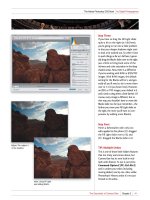The Adobe Photoshop CS5 Book for Digital Photographers part 6 ppt
Bạn đang xem bản rút gọn của tài liệu. Xem và tải ngay bản đầy đủ của tài liệu tại đây (1.3 MB, 10 trang )
ptg
31Chapter 2The Essentials of Camera Raw
The Adobe Photoshop CS5 Book for Digital Photographers
Step Six:
Now, here’s the thing: although this
can give you a perfectly accurate white
balance, it doesn’t mean that it will look
good. White balance is a creative decision,
and the most important thing is that your
photo looks good to you. So don’t get
caught up in that “I don’t like the way the
white balance looks, but I know it’s accu-
rate” thing that sucks some people in—
set your white balance so it looks right to
you. You are the bottom line. You’re the
photographer. It’s your photo, so make it
look its best. Accurate is not another word
for good. By the way, you can just Right-
click on your image to access the White
Balance pop-up menu (as shown here).
Step Seven:
Here’s a before/after so you can see
what a difference setting a proper white
balance makes (by the way, you can see
a quick before/after of your white bal-
ance edit by pressing the letter P on your
keyboard to toggle the Preview on/off).
TIP: Using the Swatch Card
To help you find that neutral light gray
color in your images, I’ve included a
swatch card in the back of this book (it’s
perforated, so you can tear it out), and it
has a special Camera Raw white balance
light gray swatch area. Once your light-
ing is set, just have your subject hold it
while you take one shot. Then, open
that image in Camera Raw, and click the
White Balance tool on the swatch card
to instantly set your white balance. Now,
apply that same white balance to all the
other shots taken under that same light
(more on how to do that coming up in
the next chapter).
Before: The As Shot
white balance has
a yellowish tint
After: With one click of
the White Balance tool,
everything comes together
Download from www.wowebook.com
ptg
32
Chapter 2 The Essentials of Camera Raw
The Adobe Photoshop CS5 Book for Digital Photographers
Step One:
The Exposure slider affects the overall
exposure of the photo (dragging to the
right makes your overall exposure lighter;
dragging to the left makes it darker). But
don’t just start dragging the Exposure
slider yet, because there’s something we
need to really watch out for, and that’s
clipping the highlights (where areas of
the photo get so bright that they lose
all detail). Luckily, Camera Raw has built-
in clipping warnings, so you don’t lose
highlight detail. First, look at this photo’s
histogram at the top right of the window.
See the solid white triangle in the top-right
corner? That’s warning you that some
parts of this photo are already clipping.
Step Two:
If you want to see exactly which areas are
clipping (so you can see if they are even
areas we need to worry about), just move
your cursor over that highlight warning
triangle, click on it, and any areas that are
clipping will show up in red (as shown
here). That see-your-clipping-areas-in-red
warning will now stay on while you’re
making your adjustments. Click on the
little highlight triangle again (or press the
letter O on your keyboard) to toggle this
feature off/on.
The next thing I fix (after adjusting the white balance) is the photo’s exposure.
Now, some might argue that this is the most essential adjustment of them all,
but if your photo looks way too blue, nobody will notice if the photo’s under-
exposed by a third of a stop, so I fix the white balance first, then I worry about
exposure. In general, I think of exposure as three things: highlights, shadows,
and midtones. So in this tutorial, I’ll address those three, which in Camera Raw
are the exposure (highlights), blacks (shadows), and brightness (midtones).
The Essential
Adjustments #2:
Exposure
SCOTT KELBY
Download from www.wowebook.com
ptg
33Chapter 2The Essentials of Camera Raw
The Adobe Photoshop CS5 Book for Digital Photographers
Continued
Step Three:
If you don’t like the red clipping warning,
or if you have a photo with a lot of red in
it, and the red warnings aren’t easily seen,
there is another warning you can use. Just
press-and-hold the Option (PC: Alt) key
and then click-and-hold the Exposure
slider. This turns your preview area black,
and any clipped areas will appear in their
color, as seen here (so if the Blue channel
is clipping, you’ll see blue; if parts of the
Green channel are clipping, you’ll see
areas of green; but of course, the worst is
to see areas in solid white, which means
all the colors are clipping). By the way,
this warning will stay on as you drag the
Exposure slider, as long as you have the
Option key held down. Also, some things
will always clip, like a photo with the sun
visible in it, or a specular highlight on
the chrome bumper of a car, but that’s
okay—they don’t have any detail. We’re
only concerned about recovering areas
that actually have important detail.
Step Four:
So, now that we know how to find out
when we have a clipping problem, how
do we make the problem go away? Well,
since this problem happens when things
get too bright, you could always drag
the Exposure slider to the left until the
clipping warnings go away. For example,
here I lowered the exposure (by dragging
the Exposure slider to the left) until the
clipping warning finally went away, but
that’s a really bad tradeoff. We fixed
one problem (clipped highlights), but
now we have another problem that may
be worse (a really underexposed photo).
Luckily, there’s something simple we can
do that lets us keep the overall exposure
where we need it, and avoid clipping the
highlights at the same time.
Download from www.wowebook.com
ptg
34
Chapter 2 The Essentials of Camera Raw
The Adobe Photoshop CS5 Book for Digital Photographers
Step Five:
Start by dragging the Exposure slider until
the exposure looks right to you (here the
exposure looked good to me, but some
of the important highlight areas were
clipping, as shown in Step Three). Now,
drag the Recovery slider (located right
below the Exposure slider) to the right,
and as you do, just the very brightest
highlights are pulled back (recovered)
from clipping. Keep dragging until the
white highlight clipping warning turns
solid black (like the one shown here),
and you’re done! By the way, you can
use that same press-and-hold-the-Option
(PC: Alt)-key trick while you’re dragging
the Recovery slider, and the screen will
turn black, revealing just the clipped
areas. As you drag to the right, you’ll
actually see the clipped areas go away.
Now you’ve got your overall exposure
where you want it, and you have detail
in all your highlights at the same time.
How sweet is that?
Step Six:
Next, I adjust the shadow areas using
the Blacks slider. Dragging to the right
increases the amount of black in the
darkest shadow areas of your photo.
Dragging to the left opens up (lightens)
the shadow areas. I switched photos
here to show you a better example of
how the Blacks slider works.
SCOTT KELBY
Download from www.wowebook.com
ptg
35Chapter 2The Essentials of Camera Raw
Continued
The Adobe Photoshop CS5 Book for Digital Photographers
Step Seven:
Increasing the blacks will usually saturate
the colors in your photo, as well, so if you
have a really washed out photo (as shown
in the previous step), just drag the Blacks
slider to the right until the color and depth
come back (as they have here). Compare
this with the original shown in the previous
step, and you can see what a dramatic dif-
ference increasing the blacks can make for
a washed out photo. Okay, let’s switch back
to the baseball photo, and pick up there.
Step Eight:
While my biggest concern is clipping the
highlights, there’s also a shadow clipping
warning to let you know when areas have
gotten so dark that they lose all shadow
detail. That warning is the triangle on the
top left of the histogram. If you move your
cursor over it and click, any areas that
are solid black will appear in bright blue
(as seen here). If there’s shadow clipping,
the only fix is to drag the Blacks slider to
the left to reduce the amount of blacks
in the shadows, but I generally don’t do
that, because to me that usually makes a
photo look flat and too low-contrast. So,
I avoid lowering the Blacks amount below
the default setting of 5 unless absolutely
necessary (here the clipped areas are just
shadows, not impor tant detail, so I ignore
them). But hey, that’s just me. You can also
use the press-and-hold-the-Option (PC:
Alt)-key trick with the Blacks slider. As you
might expect, this works in the opposite
way the highlight warning works; instead,
the preview area turns solid white, and any
areas that are solid black have lost detail
and actually have turned to solid black.
Download from www.wowebook.com
ptg
36
Chapter 2 The Essentials of Camera Raw
The Adobe Photoshop CS5 Book for Digital Photographers
Step Nine:
The next slider down is Brightness.
Since you’ve already adjusted the high-
lights (Exposure slider) and the shadows
(Blacks slider), the Brightness slider ad-
justs every thing else (I relate this slider to
the mid tones slider in Photo shop’s Levels
adjustment, so that might help in under-
stand ing how this slider differs from the
Exposure or Blacks sliders). Of the three
main adjustments (Exposure, Blacks, and
Brightness), this one I personally use the
least—if I do use it, I usually just drag
it a very short amount to the right to
open up some of the midtone detail.
But in this case, I dragged it a little to
the left to keep the photo from looking
too bright. There are no warnings for
midtones, but if you push it far enough
to the right, you could see some high-
light clipping.
Step 10:
If you don’t feel comfortable making these
adjustments yourself, you can always give
Camera Raw a crack at it by clicking the
Auto button (it’s the underlined word
Auto, shown circled here in red). When
you click on Auto, your photo will either
look better, or not. If it’s not, just press
Command-Z (PC: Ctrl-Z) to Undo the
Auto adjustment, and then try the correc-
tion yourself using the Expo sure, Blacks,
and Brightness sliders. Here, I clicked the
Default button (to the right of the Auto
button) to reset Camera Raw to its de-
faults, and then I clicked the Auto button.
In this case, it looks kinda bright to me,
and that’s why it’s important to learn to
be able to make these corrections yourself.
Download from www.wowebook.com
ptg
37Chapter 2The Essentials of Camera Raw
The Adobe Photoshop CS5 Book for Digital Photographers
Step One:
Once you have an image open in Camera
Raw, you can have Camera Raw take a
stab at setting the overall exposure (using
the controls in the Basic panel) for you
by clicking on the Auto button (shown
circled in red here). In older versions of
Camera Raw, this Auto correction fea-
ture was…well…let’s just say it was less
than stellar, but it’s gotten much better
since then, and now it does a somewhat
decent job (especially if you’re stuck and
not sure what to do), so click on it and
see how it looks. If it doesn’t look good,
no sweat—just press Command-Z (PC:
Ctrl-Z) to Undo.
Step Two:
You can set up Camera Raw so it automati-
cally performs an Auto Tone adjustment
each time you open a photo—just click
on the Preferences icon up in Camera
Raw’s toolbar (it’s the third icon from
the right), and when the dialog appears,
turn on the checkbox for Apply Auto
Tone Adjust ments (shown circled here),
then click OK. Now, Camera Raw will
evaluate each image and try to correct it.
If you don’t like its tonal corrections, then
you can just click on the Default button,
which appears to the right of the Auto
button (the Auto button will be grayed
out because it’s already been applied).
If you’re not quite comfortable with manually adjusting each image, like
I mentioned at the end of the last tutorial, Camera Raw does come with a
one-click Auto function, which takes a stab at correcting the overall exposure
of your image (including shadows, fill light, contrast, and recovery), and at this
point in Camera Raw’s evolution, it’s really not that bad. If you like the results,
you can set up Camera Raw’s preferences so every photo, upon opening
in Camera Raw, will be auto-adjusted using that same feature.
Letting Camera
Raw Auto-Correct
Yo ur Ph ot o s
Download from www.wowebook.com
ptg
38
Chapter 2 The Essentials of Camera Raw
The Adobe Photoshop CS5 Book for Digital Photographers
Step One:
The Clarity slider is found in the bottom
section of the Basic panel in Camera Raw,
right above the Vibrance and Saturation
sliders. (Although its official name is
Clarity, I heard that at one point Adobe
engineers considered naming it “Punch”
instead, as they felt using it added punch
to the image.) To clearly see the effects
of Clarity, first zoom in to a 100% view
by double-clicking on the Zoom tool up
in the toolbar (it looks like a magnifying
glass). In the example shown here, I only
zoomed to 50% so you could see more
of the image.
Step Two:
Using the Clarity control couldn’t be
easier—drag the slider to the right to
increase the amount of snap (midtone
contrast) in your image (compare the top
and bottom images shown here). Almost
every image I process gets between +25
and +50 Clarity. If the image has lots of
detail, like a cityscape, or a sweeping land-
scape shot, or something with lots of little
details like a motorcycle (or leaves and
flowers), then I’ll go as high as +75 to +80,
as seen here. If the subject is of a softer
nature, like a portrait of a child, then
in that case, I don’t generally apply any
Clarity at all.
This is one of my favorite features in Camera Raw, and whenever I show it in a class,
it never fails to get “Oooohs” and “Ahhhhs.” I think it’s because it’s just one simple
slider, yet it does so much to add “snap” to your image. The Clarity slider (which is
well-named) basically increases the midtone contrast in a way that gives your photo
more punch and impact, without actually sharpening the image (much like certain
Curves adjustments in Photoshop can add snap and punch to your photos).
Adding “Snap”
(or Softening) to
Yo ur I ma g e s U s in g
the Clarity Slider
SCOTT KELBY
Download from www.wowebook.com
ptg
39Chapter 2The Essentials of Camera Raw
The Adobe Photoshop CS5 Book for Digital Photographers
Step Three:
You can also use the Clarity control in
reverse—to soften skin. This is called
adding negative Clarity, meaning you
can apply less than 0 (zero) to reduce
the midtone contrast, which gives you
a softening effect. For example, here’s
an original image without any negative
Clarity applied.
Step Four:
Now drag the Clarity slider to the left
(which gives you a negative amount of
Clarity), and take a look at how much
softer our subject’s skin looks. Every thing
else in the image looks softer too, so it’s
an overall softening, but in the chapter
on the Adjustment Brush (Chapter 4),
you’ll learn how to apply softening just to
your subject’s skin (or anything else you
need softened), while leaving the rest of
the image sharp.
SCOTT KELBY
Download from www.wowebook.com
ptg
40
Chapter 2 The Essentials of Camera Raw
The Adobe Photoshop CS5 Book for Digital Photographers
Step One:
Here’s a pretty typical image where the
subject, shot near sunset, is backlit with
the setting sun, and while you can see
some detail, the detail areas of the subject
are mostly in the shadows.
Step Two:
Dragging the Fill Light slider to the right
opens up those lower mid-shadow areas,
and lets detail that was once hidden in
the shadows be revealed (as seen here).
If you have to deal with a backlit subject (and we all do at one time or another,
either intentionally or by accident), then you’re going to love the Fill Light slider.
Unlike the Shadow/Highlight adjustment in Photoshop (which requires you to
jump through a few hoops and tweak a number of sliders, so it doesn’t look fake
and “milky”), the Fill Light slider not only looks more natural, but because of
that, it lets you apply more Fill Light and still have your image look good.
However, there is one little tweak you’ll need to know, but it couldn’t be easier.
Fixing Backlit
Photos by
Adding Fill Light
SCOTT KELBY
Download from www.wowebook.com









